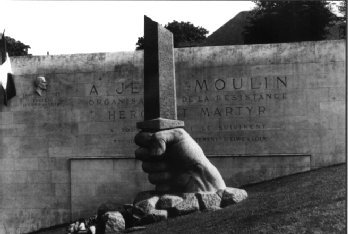The Panthéon

Panthéon in Paris

a street named after Moulin

a commemorative coin of 2 francs

a commemorative stamp

a memorial to Moulin in Chartres

a map of France
On December 19th, 1964, a bitterly cold day, the ashes of Jean Moulin (1899-1943) were transferred to the Panthéon. André Malraux, who was then a minister of Cultural Affairs, gave a speech that reduced to tears many of old veterans of French Resistance in attendance. Yet until this ceremony, his name was hardly known except by Resistance leaders. Malraux asked, "Were it not for today's ceremony, how many of France's children would know his name? He himself recovered his true name only to be killed; and since then sixteen million children have been born."
After this ceremony, Moulin became the official personification of the French Resistance. After the humiliation of the defeat of 1940, the Resistance became a very important medicine for the French psyche. And Moulin was the symbol of this precious flash of honor in that blackest time in her history. According to Malraux, he was "the leader of a people of the night", "king of shadows", and "Carnot of the Resistance." It is no wonder that his name lives on in innumerable universities, schools, and streets named after him.
But why Moulin in particular? Why did Charles de Gaulle, then the president of France, choose Moulin to represent the Resistance in the Pantheon? Why not Henri Frenay, who founded the most important non-communist resistant organization, or any one of tens of thousands who were on the frontline in the fight against the Nazis?
No doubt Moulin's acts of heroism and his tragic fate played a role. When he was the prefet of Eure-et-Loire in 1940 and the Germans forced him with torture to sign a false document describing atrocities allegedly committeed by the French colonial army, he attempted suicide by slitting his own throat. When the Gestapo arrested him at Caluire in June 1943, he was horribly tortured to death without revealing a single secret. As the unifier of French Resistance, he knew them all.
Also the scope of his mission was singular: unification of disparate resistant movements in France into the army of Resistance, which General Dwight Eisenhower said, was worth 15 divisions and shortened the war by two months. For this accomplishment, Malraux said, "it was not he who created the regiments, but it was he that created the army. He was the Carnot of the Resistance.
" And this act was paramount in ensuring that de Gaulle was eventually recognized as the head of Resistance France, thus perhaps sparing post-war France from the Allied occupation or worse, civil wars that raged in other liberated countries.
But as we will see, there was also an ulterior side to Moulin's transfer to the Panthéon. It played a part in de Gaulle's campaign to whitewash French history by hiding the shame of Vichy France behind the glory of Resistance France.
Controversies
Moulin also happens to be French JFK. Not only the circumstances of his betrayal and death have in a sense overshadowed his life, they have spurned all kinds of conspiracy theories, including two treason trials that ended in acquittal. There is little doubt that Moulin was betrayed to the Gestapo when he attended a high-level Resistance meeting in Caluire on June 21st, 1943. The question is who betrayed Moulin and why. Did Rene Hardy, who was tried twice and acquitted both times, betray Moulin under pressure of torture? Or did he betray Moulin on the order of a right-wing faction within Resistance, which suspected Moulin to be a crypto-communist? Or could it be that the communists felt Moulin betrayed his left-wing background with his allegiance to General de Gaulle? Was the French hero truly a crypto-communist in the service of Soviet Union? The debate on Caluire, which continues to this day, exposes the deep schism between the French left and right that verged on a civil war well before 1940 and continued on even within Resistance, which many prefer not to dwell on.
Even today, sixty years after his death, his life is scarcely known. Only his name remains alongside that of Voltaire and Victor Hugo in the Panthéon. If you search for "Jean Moulin" in the internet, you will get hundreds of thousands of results, but most of them are websites on countless institutions and streets named after him. You will find very little information about the man himself, which is why this humble website was made.
Moulin remians an enigma. This is largely due to secrecy necessitated by his underground works. However, as Time International (Dec 14, 1998) puts it, those enigmas help reinforce Moulin's mythic stature in France -- and provide factual gray areas in his life that allow everyone to imagine him according to their own perceptions of Resistance France.
MAIN PAGE < < < Top of
Page > > > NEXT
